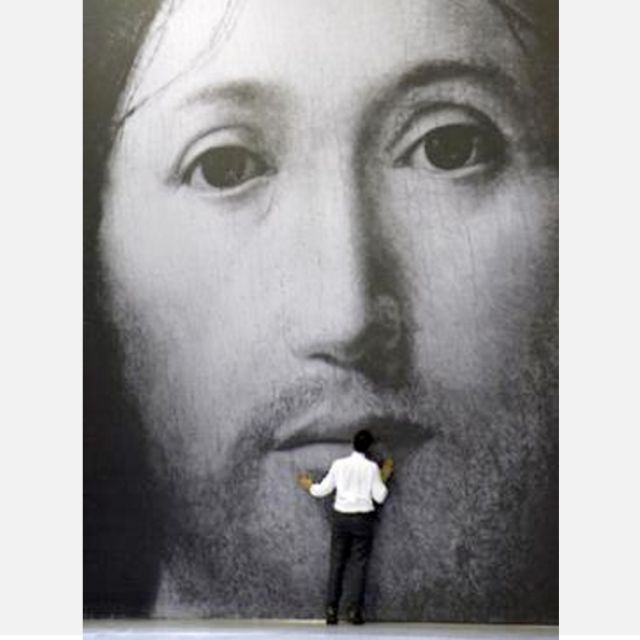Castelluci’s play touched off nightly protests when staged in France last November. Police had to prevent outraged Catholics from storming the stage and pelting cast members with rubbish. Even French bishops got into the act, publicly disagreeing as to whether Castelluci’s work was yet another appalling, blasphemous attack on the Church or a profound dialogue on the degradations of human frailty and the redemptive power of Christ’s eternal gaze.
There were neither protesters nor debating bishops to be found when we saw the play in Montreal recently, although two lone Catholic demonstrators reportedly turned up opening night.
In a city that has endured four months of violent street demonstrations by striking students, the theatre pickets were comic relief. As for Quebec clerical commentary, the only noted quote came from our programmatic chatterbox, Fr. Raymond Gravel. He, as I have written previously, will exhale on any topic provided it can be turned into further proof of the nefarious plot by Catholic social conservatives to oppress him.
Whether or not we can stomach Castelluci’s spray of an old man’s feces across an all-white set, On the Concept of the Face, Regarding the Son of God is a work of art that should be seriously discussed, not just denounced by the disgusted. The media hype may make it sound like a replay of Enemas: A Love Story but at its heart is a radically Christian triangulation of the love between a father, a son and Christ, Saviour of the World.
The 55-minute performance presents us with a young businessman caring for his enfeebled, dementia-afflicted father. Caring means changing his adult diapers, mopping the pools of his filth off the floor and kneeling behind him to sponge his buttocks and legs. The father is incapable of more than moaning, weeping and imploring his child for forgiveness. The son is by turns jocular, attentive, loving, tender and driven beyond the bounds of human endurance by what is happening to the man who gave him life.
All who have cared for a dying parent will know why. They will also be forgiven for wondering how it became theatre. As my wife, ever the Quebecoise pragmatist, said: “No one gave me a standing ovation for helping my mom like that in real life.”
Tender, beautiful, disturbing and painful as the humanity of each actor is, however, the full drama is compelled by the static, silent figure of Our Lord in a towering copy of Christ Blessing by the 15th century painter Antonello da Massina. Castelluci’s brilliance was to crop the image tightly so only the Holy Face is visible and His supernaturally merciful, loving, suffering blue eyes modulate every instant of stagecraft. His gaze transfixes us even as it transforms us.
What happens beneath it is human, all too human. What happens within it is, in the title of U.S. writer Gregory Wolfe’s 2011 book, the beauty that will save the world. As Wolfe writes: “What happens when prophecy meets art, heaven meets Earth — when divine imperatives meet the tangled human condition? Faith asks art to be about something more than formal virtuosity and to consider that meaning itself is already inherently metaphysical, even religious. Art asks faith to become incarnate in the human condition without compromise — or evasion — and remain compelling.”
Nothing is wasted that is confronted to make it anew in Christ. Including us. Including our sins.
At play’s end, when da Massina’s glorious Renaissance image is effaced through bizarre dramatic obliterations, no self-aware Christian will fail to understand from the theatrical ambiguity that we sinners are at fault. Every day we do all the things that are done to the painting of the face of the Son of God. And more. Yet that face, those eyes, remain not as concept, but as pentimento, the painting underneath the painting, the Real behind the reality of our love and our desperation.
We do not even need to wish. It is already true.
The ‘Real’ in our reality
By Peter StocklandMost of us wish the title of Greg Wolfe’s book Beauty Will Save the World could come true.
But few of us would automatically agree with the argument made in Italian dramatist Romeo Castellucci’s newest work — On the Concept of the Face, Regarding the Son of God — that even human waste can serve the faith.
Please support The Catholic Register
Unlike many media companies, The Catholic Register has never charged readers for access to the news and information on our website. We want to keep our award-winning journalism as widely available as possible. But we need your help.
For more than 125 years, The Register has been a trusted source of faith-based journalism. By making even a small donation you help ensure our future as an important voice in the Catholic Church. If you support the mission of Catholic journalism, please donate today. Thank you.
DONATE

